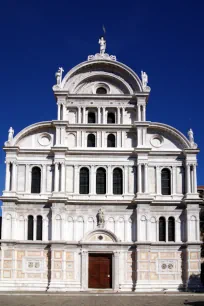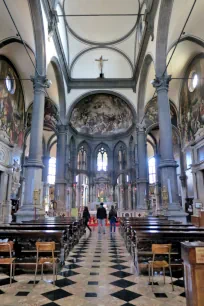Home to an amazing collection of artwork by some of Italy’s best artists, the church of San Zaccaria is one of the most photographed ecclesiastic buildings in Venice.
History
Named for the father of St. John the Baptist, St. Zacharias Church (San Zaccaria) is situated at a quiet square not far from the waterfront, just east of St. Mark’s Square. The church supposedly contains the body of Zacharias.
The original church, which sat at the same site, was built in the ninth century. It was founded by Doge Giustiniano Particiaco, and an extant crypt from that church is the burial place of eight former doges.
That structure was replaced by a Romanesque-style church built in the second half of the twelfth century, which was replaced by yet another church in the fourteenth century, this one Gothic in style and connected to a Benedictine monastery.
Finally, the current St. Zacharias Church was built between the years 1444 and 1515 and was designed by architects Antonio Gambello and Mauro Codussi, the latter of whom was responsible for completing the facade. It is considered to be one of the most important works of the Venetian Renaissance. However, the bell tower (campanile) is Byzantine in style and the choir is Gothic.
Interior
Inside, the apse is surrounded by a passageway lighted by beautiful, tall Gothic windows and the walls are lined with some of the most magnificent works of art found in Venice. Artists included in this collection are Tintoretto, Angelo Trevisani, Giuseppe Salviati, Giovanni Bellini, Antonio Balestra, Giovanni Domenico Tiepolo, Palma the Elder and Van Dyck. The most famous painting inside the church is the retable. It was painted in 1505 by Bellini and shows the Madonna with child and saints.
Fun Fact
History reports that the convent of San Zaccaria in the eighteenth century was quite unruly. Apparently, it was the place where wealthy families sent their rowdy daughters against their will, so they wouldn’t have to pay a dowry, which was customary at that time in Venice. In return for being sent away, these willful young ladies took revenge on their families by indulging in well-publicized love affairs that became the talk of the town.
- Next: Vaporetto
- More Sights & Attractions in Venice




